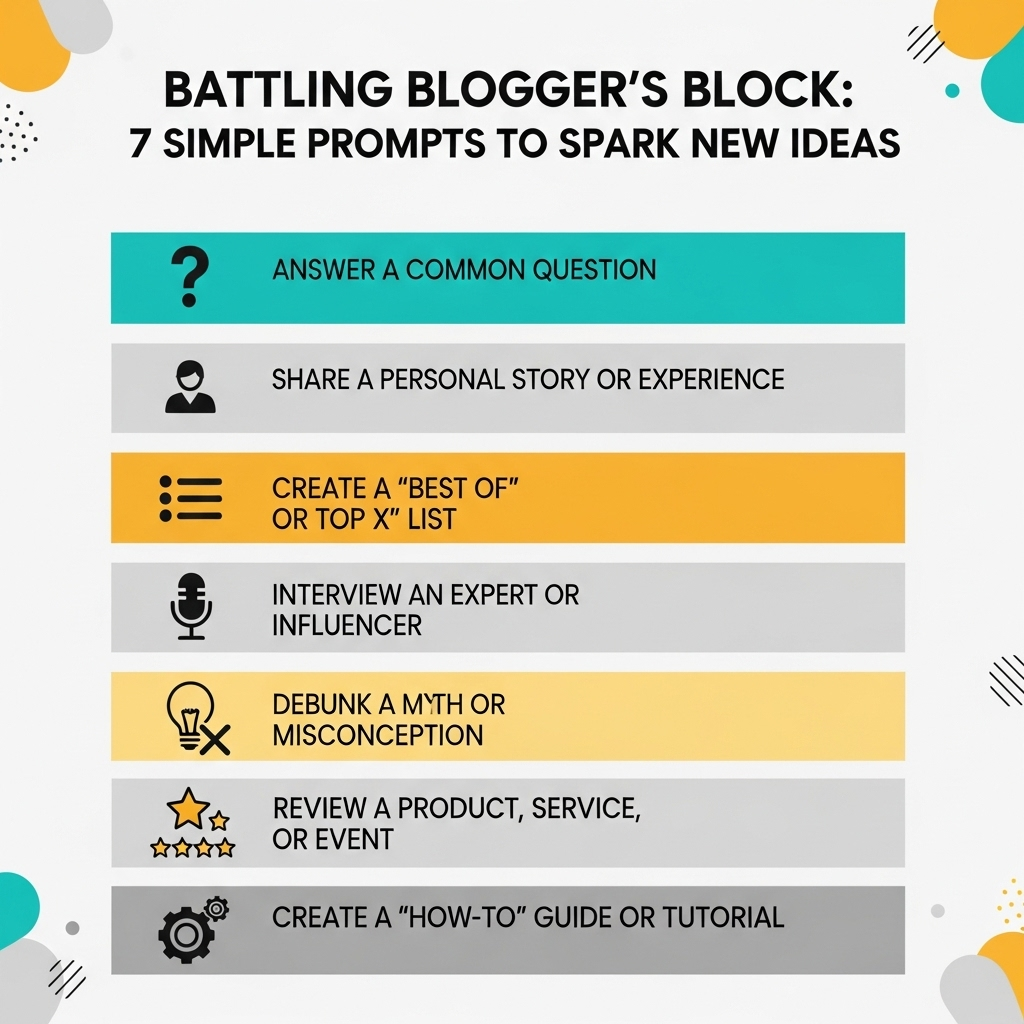
Every writer, from the seasoned professional to the budding blogger, has faced it: the dreaded blank page.
You sit down, fingers poised over the keyboard, ready to create your next masterpiece, but the words just won’t come.
Your mind feels like a barren desert, and the cursor blinks mockingly. This is blogger’s block, and it can be a frustrating and demoralizing experience.
But don’t despair.
Blogger’s block isn’t a sign that you’ve run out of ideas forever; it’s simply a temporary hurdle.
Often, all you need is a little spark to reignite your creative fire.
The key is to shift your perspective and approach your content from a new angle.
We’ve compiled seven simple and effective prompts to help you break through the block, generate a wealth of new ideas,
and get back to what you do best: creating compelling content for your audience.
1. Answer a Common Question
What are the questions you hear most often from your readers, clients, or customers?
Think about the emails you receive, the comments on your posts, or the discussions in your social media communities.
These questions are a goldmine for content ideas because they come directly from your target audience.
By addressing these frequently asked questions,
you are not only creating highly relevant and valuable content but also positioning yourself as an expert in your field.
Start by listing the top 5-10 questions you encounter.
Each one has the potential to become a detailed blog post, a helpful tutorial, or an in-depth guide.
How to apply this:
Create a “FAQ” series: Dedicate a series of posts to answering your most common questions one by one.
Go in-depth: Instead of a short answer, provide a comprehensive explanation with examples, data, and actionable tips.
Use tools: Use keyword research tools like AnswerThePublic or browse forums like Quora and Reddit to find what questions people are asking in your niche.

2. Share a Personal Story or Experience
Your unique experiences and perspective are your greatest assets as a blogger.
Sharing a personal story can create a powerful connection with your audience, making your content more relatable and memorable.
Whether it’s a success, a failure, a lesson learned, or a behind-the-scenes look at your journey, personal anecdotes build trust and humanize your brand.
Don’t be afraid to be vulnerable. Sharing challenges and how you overcame them can be incredibly inspiring and helpful to your readers who may be facing similar situations.
How to apply this:
The “How I…” post: Frame your story as a case study.
For example, “How I Doubled My Blog Traffic in Three Months” or “The Biggest Mistake I Made When Starting My Business.”
Behind-the-scenes: Give your readers a peek into your daily routine, your creative process, or the making of a product.
Lessons learned: Reflect on a past experience and share the key takeaways and advice you would give your younger self.
3. Create a “Best of” or “Top X” List
Listicles are one of the most popular and shareable formats for blog posts, and for good reason.
They are easy to scan, digest, and provide a wealth of information in a structured way.
Creating a “best of” or “top X” list can be a fun and straightforward way to generate content.
You can curate a list of your favorite tools, books, resources, or even other blog posts within your niche.
This not only provides value to your readers but also allows you to leverage existing content or products you genuinely endorse.
How to apply this:
Resource roundups: “Top 10 Tools for [Your Niche] Bloggers” or “5 Must-Read Books for [Your Audience].”
Curated content: “The Best [Topic] Articles You Missed This Month.”
Product reviews: “My Top 5 Favorite [Product Category] for Boosting Productivity.”
4. Interview an Expert or Influencer
Bringing in an outside voice can add fresh perspective and credibility to your blog.
Interviewing an expert or influencer in your field provides valuable insights for your audience and can also introduce your blog to their followers, expanding your reach.
This doesn’t have to be a formal, in-person interview; it can be done via email, video call, or even a series of questions exchanged over social media.
How to apply this:
Q&A post: Compile their answers into a Q&A format.
Guest post: Invite them to write a guest post on a topic they specialize in.
Collaborative content: Work together on a piece of content that combines your expertise.
5. Debunk a Myth or Misconception
Every industry or topic has its myths, outdated advice, or common misconceptions.
Challenging these can be a powerful way to engage your audience and establish yourself as a thought leader.
Do your research, present the facts, and explain why the common belief is incorrect.
This type of content often generates discussion and can go viral.
How to apply this:
“[Myth] Busted: The Truth About [Topic]”
“Why Everything You Know About [Topic] Is Wrong”
“Common Mistakes [Your Audience] Make and How to Avoid Them”
6. Review a Product, Service, or Event
People are constantly looking for honest reviews before making purchasing decisions or attending events.
If there’s a product, service, book, or event relevant to your niche, consider writing a detailed review.
Be honest, highlight both pros and cons, and provide actionable insights. Your readers will appreciate your transparency and trust your recommendations.
How to apply this:
Detailed product review: Include screenshots, personal experience, and a clear recommendation.
Service comparison: Compare different services within your niche to help readers choose.
Event recap: Share your takeaways and insights from a conference, workshop, or webinar.
7. Create a “How-To” Guide or Tutorial
One of the most valuable types of content you can create is a step-by-step guide that helps your audience solve a problem or learn a new skill.
Think about the processes you’ve mastered or the challenges you’ve overcome.
Break them down into simple, actionable steps.
“How-to” guides are evergreen content, meaning they remain relevant over time and can consistently drive traffic to your blog.
How to apply this:
Step-by-step tutorial: “How to Set Up Your First [Platform/Tool] Account.”
Problem/solution guide: “How to Fix [Common Problem] in [Your Niche].”
Beginner’s guide: “The Ultimate Beginner’s Guide to [Topic].”
Breaking Free from the Block
Blogger’s block is a temporary creative lull, not a permanent state.
By using these seven simple prompts, you can unlock a wealth of new ideas and get back to producing valuable, engaging content for your audience.
Don’t wait for inspiration to strike; go out and find it.
Experiment with different prompts, mix and match ideas, and most importantly, keep writing.
Your next great blog post is just a prompt away.
